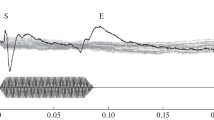Summary
We recorded late auditory potentials from lateral and medial regions in the frontal, temporal and parietal lobes of patients with temporal lobe epilepsy implanted with horizontal depth electrodes. Tone sequences were presented in three tasks: 1) auditory target detection in a tone sequence, 2) target detection with interspersed novel stimuli, and 3) detection of stimulus omissions. At frontal sites, potentials to targets showed a triphasic response with peak latencies around 200, 270 and 350 ms. At temporal sites, potentials consisted of a generally positive 285 ms peak which was sometimes accompanied by a negative peak at 200 ms or at 400 ms. At parietal sites, potentials were generally triphasic with latencies of about 230, 300, and 370 ms. At most sites, potentials evoked by novel stimuli had shorter latencies than those evoked by targets. The frontal and parietal potentials were either absent or strongly attenuated during stimulus omissions. The results lend further support to the multiple generator hypothesis of late potentials and suggest that some of the cerebral sources of the late potentials are stimulus dependent while others are not.
Similar content being viewed by others
References
Donchin, E., Ritter, W. and McCallum, W.C. Cognitive psychophysiology: the endogenous components of the ERP. In: E. Callaway, P. Tueting, and S. Koslow (Eds.), Event-related brain potentials in man. New York: Academic Press, 1978, 349–432.
Halgren, E., Squires, N.K., Wilson, C.L., Rohrbaugh, J.W., Babb, T.L. and Crandall, P.J. Endogenous potentials generated in the human hippocampal formation and amygdala by infrequent events. Science, 1980, 210:, 803–805.
Hillyard, S.A., Courchesne, E., Krausz, H.I. and Picton, T.W. Scalp topography of the P3 wave in different auditory decision tasks. In: W.C. McCallum and J.R. Knott (Eds.), The responsive brain. Bristol: J. Wright & Sons, 1976, 81–87.
Johnson, R. Scalp-recorded P300 activity in patients following unilateral temporal lobectomy. Brain, 1988, 111: 1517–1529.
Lhermitte, F., Turell, E., LeBrigand, D. and Chain, F. Unilateral visual neglect and wave P300. Arch. Neurol., 1985, 42: 567–573.
McCarthy, G., Wood, C.C., Williamson, P.D. and Spencer, D.D. Task-dependent field potentials in human hippocampal formation. J. Neurosci., (in press).
Papakostopoulos, D. and Crow, H.J. Electrocorticographic studies of the contingent negative variation and P300 in man. In: W.C. McCallum and J.R. Knott (Eds.), The responsive brain. Bristol: J. Wright & Sons, 1976, 201–204.
Richer, F., Alain, C., Achim, A., St-Hilaire, J.M. and Bouvier, J.M. Intracerebral amplitude distributions of the auditory evoked potential. Electroenceph. Clin. Neurophysiol., 1989, 74: 202–208.
Simson, R., Vaughan, H.G. and Ritter, W. The scalp topography of potentials in auditory and visual discrimination tasks. Electroenceph. Clin. Neurophysiol., 1977, 42: 528–535.
Smith, M.E. and Halgren, E. Attenuation of a sustained visual processing negativity after lesions that include the inferotemporal cortex. Electroenceph. Clin. Neurophysiol., 1988, 70: 366–369.
Snyder, E. and Hillyard, S.A. Long-latency evoked potentials to irrelevant, deviant stimuli. Behavioral Biol., 1976, 16: 319–331.
Squires, N.K., Squires, K.C. and Hillyard, S.A. Two varieties of long-latency positive waves evoked by unpredictable auditory stimuli in man. Electroenceph. Clin. Neurophysiol., 1975, 38: 387–401.
Stapelton, J.M. and Halgren, E. Endogenous potentials evoked in simple cognitive tasks: depth components and task correlates. Electroenceph. Clin. Neurophysiol., 1987, 67: 44–52.
Stapelton, J.M., Moreno, K.A. and Halgren, E. Endogenous potentials after anterior temporal lobectomy. Neuropsychologia, 1987, 25: 549–557.
Talairach, J. and Szikla, G. Atlas of stereotaxic anatomy of the telencephalon. Masson, Paris, 1967.
Velasco, M., Velasco, F., Velasco, A.L., Almanza, X. and Olvera, A. Subcortical correlates of the P300 potential complex in man to auditory stimuli. Electroenceph. Clin. Neurophysiol., 1986, 64: 199–210.
Wood, C.C., Allison, T., Goff, W.R., Williamson, P.D. and Spencer, D.D. On the neural origin of P300 in man. In: H.H. Kornhuber and L. Deecke (Eds.), Progress in Brain Research, Vol. 54. Elsevier: Amsterdam, 1980, 51–56.
Wood, C.C. and McCarthy, G. A possible frontal lobe contribution to scalp P300. Society for Neuroscience Abstracts, 1985, 11: 879.
Wood, C.C., McCarthy, G. and Squires, N.K. et al. Anatomical and physiological substrates of event-related potentials: two case studies. Ann. N.Y. Acad. Sci., 1984, 425: 681–721.
Yingling, C.D. and Hosobuchi, Y. A subcortical correlate of P300 in man. Electroenceph. Clin. Neurophysiol., 1983, 59: 72–76.
Author information
Authors and Affiliations
Additional information
This research was supported in part by grants from the Fonds de Recherche en Santé du Québec and from the Medical Research Council of Canada.
Rights and permissions
About this article
Cite this article
Alain, C., Richer, F., Achim, A. et al. Human intracerebral potentials associated with target, novel, and omitted auditory stimuli. Brain Topogr 1, 237–245 (1989). https://doi.org/10.1007/BF01129601
Accepted:
Issue Date:
DOI: https://doi.org/10.1007/BF01129601




